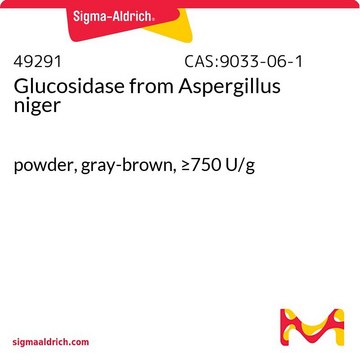SAE0020
Cellulase, enzyme blend
Sinônimo(s):
Cellic CTec2
Faça loginpara ver os preços organizacionais e de contrato
About This Item
Código UNSPSC:
12352204
NACRES:
NA.54
Produtos recomendados
forma
aqueous solution
Nível de qualidade
densidade
~1.15 g/mL
Condições de expedição
ambient
temperatura de armazenamento
2-8°C
Descrição geral
Cellulase is a member of glycoside hydrolase family and is produced by a number of cellulolytic microbes.
This product contains cellulases, ß-glucosidases, and hemicellulase, for the application of degrading cellulose to fermentable sugars. This product is effective on a wide variety of pre-treated lignocellulosic bimass materials, for converting the carbohydrates in these materials into simple sugars prior to fermentation, for application in biofuels research.
Aplicação
Cellulase, enzyme blend has been used for the purpose of enzymatic hydrolysis.
Ações bioquímicas/fisiológicas
Cellulase is responsible for the breakdown of insoluble plant polymer cellulosic substrates into soluble sugars, mostly cellobiose and glucose. It specifically catalyzes the hydrolysis of β -1,4 glucosidic bonds in cellulose. Animals do not naturally possess the ability to digest cellulose, but do so with the help of gut microorganisms.
Informações legais
A product of Novozyme Corp
Palavra indicadora
Danger
Frases de perigo
Declarações de precaução
Classificações de perigo
Resp. Sens. 1
Código de classe de armazenamento
10 - Combustible liquids
Classe de risco de água (WGK)
WGK 3
Certificados de análise (COA)
Busque Certificados de análise (COA) digitando o Número do Lote do produto. Os números de lote e remessa podem ser encontrados no rótulo de um produto após a palavra “Lot” ou “Batch”.
Já possui este produto?
Encontre a documentação dos produtos que você adquiriu recentemente na biblioteca de documentos.
Os clientes também visualizaram
Liwen He et al.
Bioresource technology, 289, 121693-121693 (2019-07-02)
The optimum condition of steam explosion pretreatment was screened for hippophae, and anaerobic calcium oxide (CaO) alkalization was further used to improve its enzymatic hydrolysis. Steam-exploded hippophae reached the lowest pH value (4.01) and the maximal hemicellulose removal (77.16%) at
A cellulase gene of termite origin.
Watanabe H, et al.
Nature, 394(6691), 330-330 (1998)
Model of acetic acid-affected growth and poly (3-hydroxybutyrate) production by Cupriavidus necator DSM 545.
Marudkla J, et al.
Journal of Biotechnology, 268, 12-20 (2018)
Liwen He et al.
Bioresource technology, 298, 122510-122510 (2019-12-15)
A better understanding of biomass usability during storage would offer basis for management decisions in production. High-moisture corn stover was ensiled with sulfuric acid (H2SO4, 0.3% and 0.6%) or sodium hydroxide (NaOH, 0.5% and 1.0%) and ensiling characteristics, lignocellulosic profile
Qiulu Chu et al.
Biotechnology for biofuels, 14(1), 136-136 (2021-06-14)
Ethanol organosolv (EOS) pretreatment is one of the most efficient methods for boosting biomass saccharification as it can achieve an efficient fractionation of three major constituents in lignocellulose. However, lignin repolymerization often occurs in acid EOS pretreatment, which impairs subsequent
Nossa equipe de cientistas tem experiência em todas as áreas de pesquisa, incluindo Life Sciences, ciência de materiais, síntese química, cromatografia, química analítica e muitas outras.
Entre em contato com a assistência técnica










